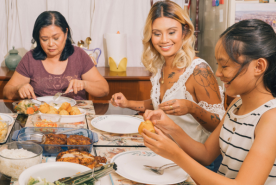Plan for emergencies to manage diabetes and health if you skip dialysis. Store non-perishable food, medications, and essential supplies.
Why do I need an emergency meal plan?
This meal plan is for you to use in case of an emergency or a natural disaster when you may not be able to got to dialysis. It is important to follow a limited diet if you miss a dialysis session. A grocery list and a three-day meal plan for an emergency are included in this fact sheet. This diet is stricter than your usual diet. This very strict plan is needed to control the buildup of toxins, potassium, phosphorus, and fluid that can be life threatening to you if dialysis treatments are missed due to the emergency.
What should I expect during an emergency situation?
Many things we depend on daily may not be working during an emergency. You may be without a telephone. Water and electricity may be cut off, keeping you from cooking your meals in the usual way. You may need to use cold or shelf-stable foods until the crisis is over. Food in your refrigerator will keep safely for up to 12 hours and in the freezer for one to two days, if these appliances are opened only when meals are prepared. It is best to eat the foods from your refrigerator and freezer first before using your shelf-stable foods. You should always have bottled/Distilled water and disposable plates and utensils on hand at all times in case of an emergency..
How do I prepare myself for an emergency?
As natural disasters may happen without warning, it is good to keep foods with a long shelf-life on hand at all times. If you do stock foods, remember to check dates for freshness and replace regularly.
The following items are important and useful to have on hand in case of an emergency:
- this diet sheet
- always have a two-week supply of all medicines and vitamins
- all of the groceries listed in this guide
- diabetics need to have enough insulin and supplies on hand, including extra batteries for the glucometer
- emergency phone list with names and phone numbers of your doctor, dialysis unit, and the local hospital
- radio with extra batteries
- flashlight with extra batteries
- candles and matches
- measuring cups and scale
- plastic forks, spoons, knives, plates, bowls, and cups
- napkins
- hand-operated can opener
- five gallons of distilled water
- refrigerator thermometer
Is there anything else I should know?
- It is very important to follow your diet according to the meal plan given.
- Be careful when eating perishable foods to avoid food poisoning. If a jar or can is opened, do not keep it longer than four hours unless refrigerated.
- Use a refrigerator thermometer to know if food is stored at a safe temperature (under 40 degrees F, 5 degrees C). If your refrigerator temperature is over 40 degrees F, food will only be safe for four hours. After that time, throw it away.
- Use disposable plates and utensils. Throw away after use.
- Keep distilled water handy for mixing milk or juice. Mix small amounts of only four ounces at a time.
- Limit intake of fluid to two cups or 16 ounces per day. Chew gum to help cope with thirst.
- Do not use salt or salt substitute with your meals. Use salt-free foods when possible.
- Avoid high-potassium foods. Limit the kinds and portion sizes of fruits and vegetables eaten to those listed in this handout.
- If you have diabetes, keep instant glucose tablets, sugar, hard candy, low-potassium fruit juices, or sugared soda pop on hand to treat low blood sugars. Avoid high potassium fruit juices (orange juice).
Three-Day Diabetic Grocery List for Emergencies
| Item | Amount (per person) |
| Bread/Cereal (use 6-8 servings per day) | |
| White bread | 1 loaf |
| Dry cereal, unsalted, unsweetened | 6 single serve containers or 1 box |
| Puffed wheat or rice, shredded wheat | |
| Vanilla wafers or | 1 box |
| Graham crackers or | |
| Unsalted crackers | |
| Unsweetened Fruits/Juices (limit to 2-4 servings per day) | |
| Canned or sealed plastic container: applesauce, pears, peaches, pineapple, mandarin oranges, fruit cocktail | 12 single-serve containers |
| Apple or Cranberry Juice | 12 boxes or pouches |
| Sugar-free powdered drink mix fruit flavored, fruit punch or lemonade | 1 canister or 2 packages |
| Sugar-free lemon lime or ginger ale soda | 6 cans |
| Fish/Meat (limit to 3 oz. per day) low-sodium, canned: | |
| Tuna, salmon, meat, turkey, chicken | 6 small cans |
| Peanut butter, unsalted | 1 jar |
| Milk (limit to ½ cup per day) | |
| Evaporated milk | 3 small cans |
| Dry milk solids | 2 packages |
| Artificial Sweetener | 1 box of packets |
| Sweets (use only to treat low blood sugar) | |
| Sourballs, hard candies | 1 bag |
| Corn Syrup | 1 bottle |
| White sugar | 1 small bag |
| Jelly | 1 jar |
| Sugared lemon-lime or ginger ale soda. Limit use of soda to avoid fluid overload | 3-12 ounce cans |
| Fats (use 6 or more servings per day) | |
| Salad or cooking oil | 1 bottle |
| Mayonnaise (perishable after opening) | Individual packets or 3 small jars |
| Margarine | 1 pound |
| Other | |
| Distilled water | 5 one gallon jugs |
Three-Day Diabetic Meal Plan for Emergencies
The sample meal plans given provide about 40-50 grams of protein, 1,500 mg sodium, 1,500 mg potassium, 1,800 calories and less than 500 cc or 16 ounces of fluid for each of the three days. You may make changes within a diabetic exchange group to fit your individual taste. These meal plans are stricter than your normal kidney and diabetic diet to keep wastes from building up in your blood during the emergency.. Fluid is limited to less than 500 cc (two cups or 16 ounces) each day to prevent you from swelling or having shortness of breath. If the disaster should continue for more than three days, the meal plan should be repeated.
Day 1
Breakfast
Morning Snack
6 unsalted crackers 1 tablespoon margarine spread on crackers
Lunch
¼ cup low-sodium tuna (open new can daily)
1 tablespoon margarine or mayonnaise (single packet or open new jar daily)
½ cup pears in unsweetened juice (single serving)
½ cup sugar free beverage
Afternoon Snack
5 vanilla wafers
Dinner
½ cup (2 oz.) low sodium chicken (open new can daily)
2 tablespoons margarine or mayonnaise (single packet or open new jar daily)
½ cup peaches in unsweetened juice (single serving)
½ cup unsweetened apple juice (from box or pouch)
Evening Snack
3 graham cracker squares
Note:
- Use one tablespoon peanut butter if you need a protein source at evening snack.
- Continue to test your blood sugar.
- Follow your usual care plan for insulin reactions and be sure to keep enough supplies on hand. Best choices for treating low sugars are fluid-free items such as sugar, corn syrup, hard candy, instant glucose, and glucose tablets. Sugared soda and low potassium juices may also be used, but must be counted as part of your two-cup or 16-ounce daily limit.
Day 2
Breakfast
or mix ¼ cup evaporated milk with ¼ cup distilled water
1 single serving box of cereal (½ - ¾ cup from box)
2 teaspoons artificial sweetener (optional)
½ cup unsweetened applesauce (single serving)
Morning Snack
5 vanilla wafers
Lunch
2 tablespoons low sodium peanut butter
1 tablespoon margarine or mayonnaise (single packet or open new jar daily)
½ cup mandarin oranges in unsweetened juice (single serving)
½ cup sugar free beverage or soda
Afternoon Snack
6 unsalted crackers
1 Tablespoon margarine spread on crackers
Dinner
½ cup (2 oz.) low-sodium chicken (open new can daily)
2 tablespoons margarine or mayonnaise (single packet or open new jar daily)
½ cup pineapple packed in unsweetened juice (single serving)
½ cup unsweetened apple juice (from box or pouch)
Evening Snack
3 graham cracker squares
Note:
- Use one tablespoon peanut butter if you need a protein source at evening snack.
- Continue to test your blood sugar.
- Follow your usual care plan for insulin reactions and be sure to keep enough supplies on hand. Best choices for treating low sugars are fluid-free items such as sugar, corn syrup, hard candy, instant glucose, and glucose tablets. Sugared soda and low potassium juices may also be used, but must be counted as part of your two-cup or 16-ounce daily limit.
DAY 3
Breakfast
or ¼ cup evaporated milk with ¼ cup distilled water
1 single serving box of cereal (½ - ¾ cup from box)
2 teaspoons artificial sweetener (optional)
½ cup pears packed in unsweetened juice (single serving)
Morning Snack
6 unsalted crackers
1 tablespoon margarine
Lunch
¼ cup (2 oz.) low-sodium turkey (open new can daily)
1 tablespoon margarine or mayonnaise (single packet or open new jar daily)
½ cup peaches packed in unsweetened juice (single serving)
½ cup sugar free drink or soda
Afternoon Snack
5 vanilla wafers
Dinner
½ cup (2 oz.) low-sodium chicken (open new can daily)
2 tablespoons margarine or mayonnaise (single packet or open new jar daily)
½ cup fruit cocktail (single serving)
½ cup cranberry juice (from box or pouch)
Evening Snack
Note:
- Use one tablespoon peanut butter if you need a protein source at evening snack.
- Continue to test your blood sugar.
- Follow your usual care plan for insulin reactions and be sure to keep enough supplies on hand. Best choices for treating low sugars are fluid-free items such as sugar, corn syrup, hard candy, instant glucose, and glucose tablets. Sugared soda and low potassium juices may also be used, but they must be counted as part of your two-cup or 16-ounce daily limit.
More than 37 million Americans—one in seven adults—have chronic kidney disease, and most don't even know it. More than 20 million others are at increased risk. The National Kidney Foundation, a major voluntary health organization, seeks to prevent kidney and urinary tract diseases, improve the health and well-being of individuals and families affected by these diseases, and increase the availability of all organs for transplantation. Through its 50 affiliates nationwide, the foundation conducts programs in research, professional education, patient and community services, public education and organ donation. The work of the National Kidney Foundation is funded by public donations.
The National Kidney Foundation wishes to thank its
Council on Renal Nutrition (CRN) for the development of this fact sheet.
If you would like more information, please contact us.
© 2019 National Kidney Foundation. All rights reserved. This material does not constitute medical advice. It is intended for informational purposes only. Please consult a physician for specific treatment recommendations.

















